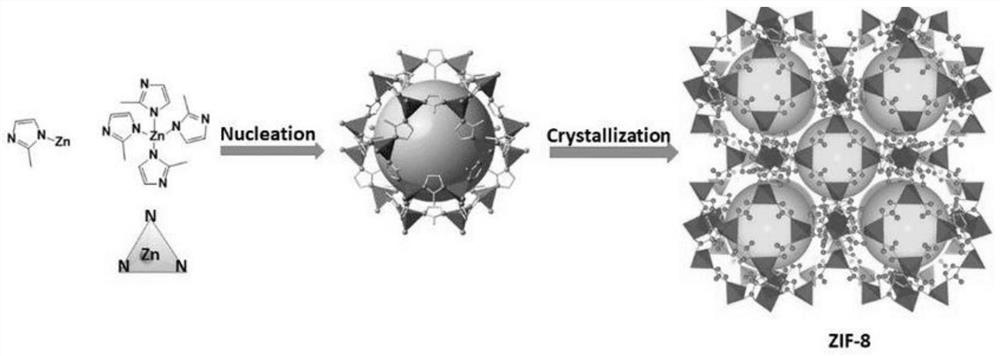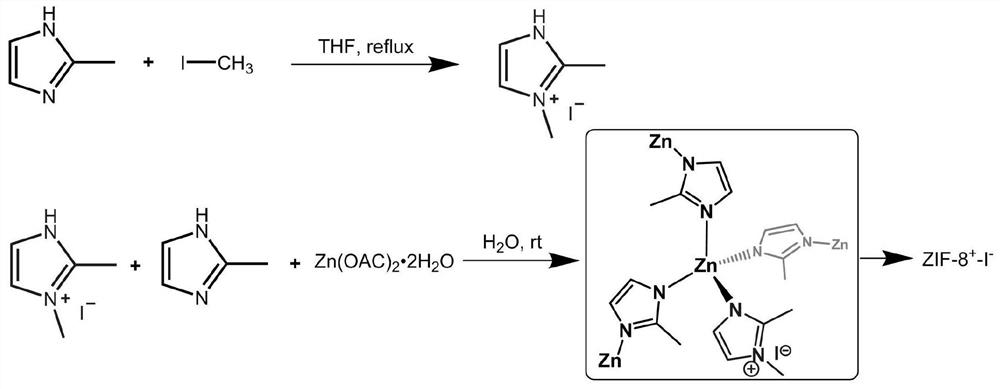Cation defect type ZIF porous material as well as preparation method and application thereof
A technology of porous materials and cations, applied in the field of cation-deficient ZIF-based porous materials and their preparation, can solve the problems of weak binding, reduced drug loading, and low internalization rate of tumor cells, so as to improve the speed and degree of internalization. , promote interaction, and synthesize green simple effects
- Summary
- Abstract
- Description
- Claims
- Application Information
AI Technical Summary
Problems solved by technology
Method used
Image
Examples
Embodiment 1
[0049] 1) Synthesis of imidazolyl cationic ligands
[0050] First, 2-methylimidazole (411mg, 5mmol) was added to the reaction flask, then tetrahydrofuran (20mL) was added to completely dissolve 2-methylimidazole, and finally methyl iodide (710mg, 5mmol) was added, and the temperature was raised to 65°C for reaction Overnight, after the reaction, a large amount of light yellow imidazolyl cationic ligands were precipitated from THF. The product was centrifuged, washed with THF several times to remove excess methyl iodide, and dried to obtain the product of the first step. 1 H NMR (400MHz,D 2 O) δ7.36–7.27 (m, 2H), 3.79 (d, J=0.9Hz, 3H), 2.61 (d, J=9.5Hz, 3H), see the results Figure 4 , it can be seen from the NMR data that there is a methyl single peak at the shift value of 3.79, which is that the "N" on 2-methylimidazole is methylated to form "N + -CH 3 " group, thus demonstrating the synthesis of the target product.
[0051] 2) ZIF-8 + -I - Synthesis
[0052] Weigh 2-m...
Embodiment 2
[0054] 1) Synthesis of imidazolyl cationic ligands
[0055] First, 2-methylimidazole (411mg, 5mmol) was added to the reaction flask, then tetrahydrofuran (20mL) was added to completely dissolve 2-methylimidazole, and finally methyl iodide (710mg, 5mmol) was added, and the temperature was raised to 65°C for reaction Overnight, after the reaction, a large amount of light yellow imidazolyl cationic ligands were precipitated from THF. The product was centrifuged, washed with THF several times to remove excess methyl iodide, and dried to obtain the product of the first step.
[0056] Separately weigh 2-methylimidazole (1230 mg, 15 mmol) and imidazolyl cationic ligand (168 mg, 0.75 mmol), and dissolve them completely in 5 mL of deionized water. In addition, zinc acetate (83mg, 0.38mmol) was weighed and dissolved in 5mL of deionized water. Finally, the two solutions were fully mixed and left to stand for 5h to finally obtain a milky white solution. Centrifugal separation (10,000r / min...
Embodiment 3
[0058] 1) Synthesis of imidazolyl cationic ligands
[0059]First, add imidazole (341mg, 5mmol) into the reaction flask, then add dimethylformamide (20mL) to completely dissolve the imidazole, finally add iodomethane (710mg, 5mmol), and raise the temperature to 55°C for 24h, the reaction is over Finally, it can be seen that a large amount of light yellow imidazolyl cationic ligands are precipitated from dimethylformamide, the product is centrifuged, washed with dimethylformamide several times to remove excess iodomethane, and dried to obtain the first step product.
[0060] 2) ZIF-8 + -I - Synthesis
[0061] Weigh imidazole (1022 mg, 15 mmol) and imidazolyl cationic ligand (210 mg, 1 mmol) and dissolve them completely in 5 mL of deionized water. In addition, zinc nitrate (89mg, 0.3mmol) was weighed and dissolved in 5mL of deionized water. Finally, the two solutions were fully mixed and left to stand for 5h to finally obtain a milky white solution, which was centrifuged (10,0...
PUM
 Login to View More
Login to View More Abstract
Description
Claims
Application Information
 Login to View More
Login to View More - R&D
- Intellectual Property
- Life Sciences
- Materials
- Tech Scout
- Unparalleled Data Quality
- Higher Quality Content
- 60% Fewer Hallucinations
Browse by: Latest US Patents, China's latest patents, Technical Efficacy Thesaurus, Application Domain, Technology Topic, Popular Technical Reports.
© 2025 PatSnap. All rights reserved.Legal|Privacy policy|Modern Slavery Act Transparency Statement|Sitemap|About US| Contact US: help@patsnap.com



